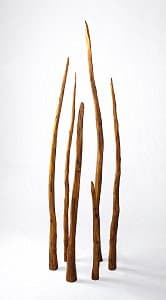

Rosemarie Castoro
Learn more... trap 1977
1977 Rosemarie Castoro Purchased 1979
More detail | PermalinkRosemarie Castoro emerged in the mid 1960s as an abstract painter. Her move to sculpture a decade later was prompted by frustrations with the limitations of the canvas. A choreographer and dancer, she became concerned with expressing the physicality and energy of line beyond the two-dimensional plane, and explored many media: performance and the written word, painting, sculpture, Land art, audio-visual works and installations. Just as the artist’s long career and fluid movement between media defy categorisation, …trap 1977 defies confident interpretation, remaining as enigmatic as the ellipses in its title suggest.[1]
…trap consists of six single branches standing upright, arranged to form a small oval enclosure. Each branch varies in height, with the longest standing almost two metres high. The branches are tapered at the ends, like long canine teeth growing from the ground. Castoro’s evocative choice of title reflects the ambiguity of the work, prompting the audience to ponder what prey the trap is designed to catch. It is slightly larger than human size, with the effect that the viewer is drawn to step through the gaps, yet the enclosure is too small to contain a person and the gaps are too wide to trap anything smaller.
The artist started using natural materials in Georgia bush dance 1974. This temporary outdoor installation at Mount Berry, Georgia consisted of tree branches that metamorphosed into outstretched limbs and free-flowing bodies in a circular formation. Castoro explored the inherent expressive qualities of the branches as a way of capturing subtle shades of meaning. While Georgia bush dance consisted of a very large, loosely-populated ring of rough, twiggy branches that captured the freedom and ebullience of a traditional circle dance, the branches used in …trap have been carefully chosen, finished and positioned to create a deliberate, almost menacing air of separation.
Although never overt, Castoro’s art is sexually charged. Lucy Lippard described it as ‘too fast to be sensuous, too controlled to release all of its energy; it exists in a state of extremely structured tension’, and the artist herself saw her work as an extension of her own body.[2] Against this background, the question as to the type of trap the work evokes may be reconsidered: the title calls to mind the gynephobically-named Venus Flytrap and also relates the work to Beaver’s trap 1977–78,[3] a larger, square, variation on the theme, the title of which alludes to the meaning in Italian of the artist’s surname and is, of course, a euphemism for female genitalia.
Although Castoro did not characterise herself as a feminist, she was frustrated by the imbalance in recognition between male and female artists, as exemplified by an interaction she related to Art News in January 1971: ‘“Castoro, Castoro, I saw your paintings at Johnny’s. I liked them very much, I thought you were a boy.”’[4] While the title …trap may hint at her frustration in her professional life, and while her work in many ways is a manifestation of her own body, Castoro’s art, and her view of the world, was balanced, characterised in her journals as the masculine animus and feminine anima of Jungian psychology.[5]
Bronwyn Campbell[6]
[1] Michael Wardell, ‘Rosemarie Castoro’, in Landscape–Art: Two way reaction, Australian National Gallery, Canberra, 1980, p [7].
[2] Lucy R Lippard, ‘Rosemarie Castoro: Working out’, Artforum, vol 13, no 10, Summer 1975, p 60.
[3] Written to MACBA to find out who owns it – on display until 15 April – WAITING ON ARRIVAL OF CATALOGUE AT LIBRARY
[4] Rosemarie Castoro, ‘Artists Transgress All Boundaries’ from ‘Eight Artists Reply: Why There Have Been No Great Women Artists’, ArtNews, vol 69, January 1971, p 45.
[5] Artist’s journal entry, reprinted in exhibition catalogue, Rosemarie Castoro: Suspensions, Syracuse University Lubin House, New York, 1973.
[6] See also Angela Silk, ‘...trap’, unpublished manuscript, National Gallery of Australia, 2004.

